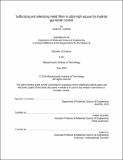| dc.contributor.advisor | Rafael Jaramillo. | en_US |
| dc.contributor.author | Luhman, Xavier D. | en_US |
| dc.contributor.other | Massachusetts Institute of Technology. Department of Materials Science and Engineering. | en_US |
| dc.date.accessioned | 2019-10-04T21:32:00Z | |
| dc.date.available | 2019-10-04T21:32:00Z | |
| dc.date.copyright | 2019 | en_US |
| dc.date.issued | 2019 | en_US |
| dc.identifier.uri | https://hdl.handle.net/1721.1/122393 | |
| dc.description | This electronic version was submitted by the student author. The certified thesis is available in the Institute Archives and Special Collections. | en_US |
| dc.description | Thesis: S.B., Massachusetts Institute of Technology, Department of Materials Science and Engineering, 2019 | en_US |
| dc.description | Cataloged from student-submitted PDF version of thesis. | en_US |
| dc.description | Includes bibliographical references (page 30). | en_US |
| dc.description.abstract | Molecular beam epitaxy (MBE) is an important, well-established method for creation of thin films. The addition of gaseous sources of hydrogen sulfide and hydrogen selenide is not currently a well-documented or common modification to such systems. While the thermodynamics of using such sources for the production of various chalcogenide thin films are favorable, the actual results thus far do not demonstrate the desired outcome. This indicates that the kinetics of the desired reactions are inhibiting the process. Compared to oxygen, reactions involving sulfur and selenium are slow. In order to ensure that the hydride gases have the opportunity to react as desired, it is necessary to keep the system free of oxygen and to maximize the collisions of gas molecules with the substrate. The first requirement should be achieved simply by using MBE for the process. The second requirement is not provided for in a typical MBE system. Thus, modifications are necessary to increase the reaction rate of the gases, namely by extending the source lines to be closer to the substrate. This thesis addresses the design process for tubing inserts in an existing MBE system. | en_US |
| dc.description.statementofresponsibility | by Xavier D. Luhman. | en_US |
| dc.format.extent | 30 pages | en_US |
| dc.language.iso | eng | en_US |
| dc.publisher | Massachusetts Institute of Technology | en_US |
| dc.rights | MIT theses are protected by copyright. They may be viewed, downloaded, or printed from this source but further reproduction or distribution in any format is prohibited without written permission. | en_US |
| dc.rights.uri | http://dspace.mit.edu/handle/1721.1/7582 | en_US |
| dc.subject | Materials Science and Engineering. | en_US |
| dc.title | Sulfurizing and selenizing metal films in ultra-high vacuum by hydride gas kinetic control | en_US |
| dc.type | Thesis | en_US |
| dc.description.degree | S.B. | en_US |
| dc.contributor.department | Massachusetts Institute of Technology. Department of Materials Science and Engineering | en_US |
| dc.identifier.oclc | 1120771784 | en_US |
| dc.description.collection | S.B. Massachusetts Institute of Technology, Department of Materials Science and Engineering | en_US |
| dspace.imported | 2019-10-04T21:31:59Z | en_US |
| mit.thesis.degree | Bachelor | en_US |
| mit.thesis.department | MatSci | en_US |
